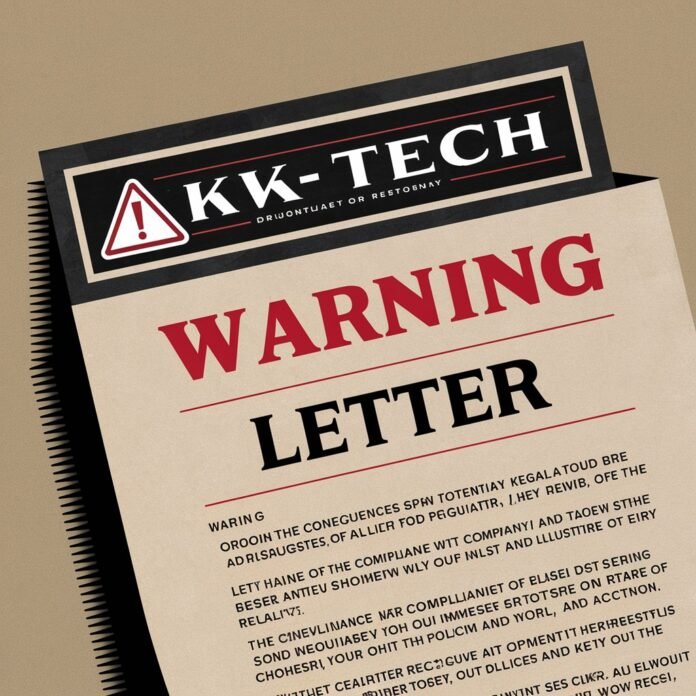Introduction
Receiving a KVK-Tech warning letter can be a concerning experience for businesses and individuals alike. Whether it relates to compliance violations, contractual breaches, or intellectual property disputes, such letters often carry significant legal and operational consequences. KVK-Tech, known for its stringent adherence to industry standards, issues these warnings to address non-compliance, unauthorized use of technology, or failure to meet agreed-upon terms. This article explores the key aspects of a KVK-Tech warning letter, including common reasons for issuance, how to respond effectively, and strategies to mitigate risks. By understanding the implications and taking prompt action, recipients can navigate this challenge while protecting their interests.
1. Common Reasons for Receiving a KVK-Tech Warning Letter
A KVK-Tech warning letter is typically sent when the company detects violations of its policies, contracts, or legal requirements. Common reasons include unauthorized use of proprietary technology, failure to comply with licensing agreements, or breaches of confidentiality clauses. In some cases, the letter may address delayed payments, misuse of trademarks, or failure to meet quality standards in collaborative projects. Understanding the specific allegations is crucial, as each scenario demands a tailored response. Whether the issue stems from negligence or a misunderstanding, identifying the root cause helps in formulating an appropriate resolution strategy.
2. Legal and Financial Implications of Ignoring the Warning
Ignoring a KVK-Tech warning letter can lead to severe repercussions, including lawsuits, financial penalties, and termination of business relationships. KVK-Tech may escalate the matter by filing for injunctions, demanding compensation, or pursuing criminal charges in cases of fraud or intellectual property theft. Additionally, non-compliance could damage a company’s reputation, affecting partnerships and customer trust. Proactively addressing the warning demonstrates professionalism and a commitment to resolving disputes amicably, reducing the risk of prolonged legal battles. Legal counsel should be consulted to assess potential liabilities and ensure all communications align with regulatory requirements.
3. How to Respond to a KVK-Tech Warning Letter
Crafting a well-structured response to a KVK-Tech warning letter is critical in de-escalating the situation. The first step involves acknowledging receipt of the letter and conducting an internal investigation to verify the claims. If the allegations are valid, proposing corrective actions—such as ceasing unauthorized activities, compensating for damages, or renegotiating terms—can demonstrate goodwill. If the warning is based on a misunderstanding, providing documented evidence to refute the claims is essential. All correspondence should remain professional, concise, and free of confrontational language. Engaging legal experts to review the response ensures compliance and strengthens the defense if further disputes arise.
4. Preventing Future Compliance Issues with KVK-Tech
To avoid receiving another KVK-Tech warning letter, businesses should implement robust compliance frameworks. This includes regular audits of contracts, intellectual property usage, and operational processes to ensure alignment with KVK-Tech’s policies. Employee training on legal obligations, licensing terms, and data security can minimize unintentional violations. Maintaining transparent communication with KVK-Tech, including timely reporting of potential issues, fosters a cooperative relationship. Additionally, keeping detailed records of all agreements and transactions provides a safeguard in case of future disputes. Proactive compliance not only mitigates risks but also enhances long-term business credibility.
5. Case Studies: Lessons from Past KVK-Tech Disputes
Examining previous cases involving KVK-Tech warning letters offers valuable insights into best practices for resolution. For instance, a software company that inadvertently violated licensing terms avoided litigation by promptly negotiating a settlement and updating its compliance protocols. Conversely, a manufacturer that ignored repeated warnings faced costly legal action and reputational damage. These examples highlight the importance of timely intervention and adherence to contractual obligations. Learning from others’ mistakes helps businesses develop preventive measures and effective response strategies when dealing with KVK-Tech’s enforcement actions.
Conclusion
A KVK-Tech warning letter serves as a critical alert that demands immediate attention. Whether addressing compliance lapses, contractual breaches, or intellectual property concerns, recipients must approach the situation with diligence and professionalism. By understanding the allegations, crafting a strategic response, and implementing preventive measures, businesses can resolve disputes efficiently while safeguarding their operations. Ignoring such warnings risks legal and financial consequences, making proactive engagement the best course of action. With the right approach, companies can turn a potential crisis into an opportunity for improved compliance and stronger partnerships.


